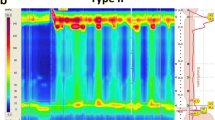Abstract
The unequivocal diagnosis of esophageal chest pain requires the demonstration of simultaneous manometric changes and chest pain. Numerous provocative agents have been used to enhance the diagnostic value of esophageal manometry. Our aims were to: (1) evaluate consecutively a large group of patients with proven noncardiac chest pain and normal baseline manometric studies, using edrophonium chloride, 10 mg, and (2) determine the value of provocative testing in clinical practice. One hundred twenty patients with normal standard baseline esophageal manometries were studied using blinded testing with edrophonium chloride and followed clinically by questionnaire. A positive response of both chest pain and manometric changes was observed in 34%, a negative response in 49%, and an indeterminate response in 17% of patients. Baseline manometric features, including high-amplitude contractions, did not predict the response to edrophonium chloride. Following edrophonium chloride administration, the change in amplitude, duration, and number of repetitive contractions from baseline was significantly greater in positive responders. Edrophonium decreased the velocity of propagated contractions in positive responders (P<0.05), but not in nonresponders. Response to edrophonium chloride could not be predicted by patient age, sex, or clinical symptomatology. Seventy percent of patients in both groups had symptoms indistinguishable from ischemic heart disease. After making a specific diagnosis of esophageal chest pain, patients showed a marked clinical improvement, with a significant decrease in physical limitation, emergency room visits, hospital and CCU admissions, and in further cardiac testing. We conclude that provocative testing with edrophonium chloride will make it possible to definitively implicate the esophagus in over 30% of patients with normal baseline manometric findings and noncardiac chest pain.
Similar content being viewed by others
References
Brand DL, Martin D, Pope CE: Esophageal manometrics in patients with angina-like chest pain. Am J Dig Dis 22:3000–304, 1977
London RL, Ouyang A, Snape WJ Jr, Goldberg S, Hirshfeld JW, Cohen S: Provocation of esophageal pain by ergonovine or edrophonium. Gastroenterology 81:10–14, 1981
Davies HA, Kaye MD, Rhodes J, Dart AM, Henderson AH: Diagnosis of esophageal pain by ergometrine provocation. Gut 23:89–92, 1982
Benjamin SB, Richter JE, Cordova CM, Knuff TE, Castell DO: Prospective manometric evaluation with pharmacologic provocation of patients with suspected esophageal motility dysfunction. Gastroenterology 84:893–901, 1983
Koch KL, Curry C, Feldman RL, Pepine CJ, Long A, Mathias JR: Ergonovine induced esophageal spasm in patients with chest pain resembling angina pectoris. Dig Dis Sci 27:1073–1080, 1982
Meshkinpour H, Glick ME, Sanchez P, Tarvin J: Esophageal manometry. A benefit and cost analysis. Dig Dis Sci 27:772–775, 1982
Clouse RE, Staiano A: Contraction abnormalities of the esophageal body in patients referred for manometry. Dig Dis Sci 28:784–790, 1983
Kramer P, Flesher B, McNally E, Harris LD: Oesophageal sensitivity to mecholyl in symptomatic diffuse spasm. Gut 8:120–127, 1967
Orlando RC, Bozymski EM: The effects of pentagastrin in achalasia and diffuse esophageal spasm. Gastroenterology 77:472–477, 1979
Mellow M: Symptomatic diffuse esophageal spasm, manometric follow-up and clinical response to cholinergic stimulation and cholinesterase inhibition. Gastroenterology 23:237–240, 1977
DiMarino AJ Jr, Cohen S: Characteristics of lower esophageal sphincter function in symptomatic diffuse esophageal spasm. Gastroenterology 66:1–6, 1974
Richter JE, Hackshaw BT, Wu WC, Castell DO: Edrophonium: A useful provocative test for esophageal chest pain. Ann Intern Med 103:14–21, 1985
Ockene IS, Shay MJ, Salpert JS, Weiner BH, Dalen JE: Unexplained chest pain in patients with normal coronary arteriograms: A follow-up study of functional status. N Engl J Med 303:1249–1252, 1980
Author information
Authors and Affiliations
Additional information
Dr. Lee was at the University of Pennsylvania at the time of the study.
Rights and permissions
About this article
Cite this article
Lee, C.A., Reynolds, J.C., Ouyang, A. et al. Esophageal chest pain. Digest Dis Sci 32, 682–688 (1987). https://doi.org/10.1007/BF01296132
Received:
Revised:
Accepted:
Issue Date:
DOI: https://doi.org/10.1007/BF01296132




